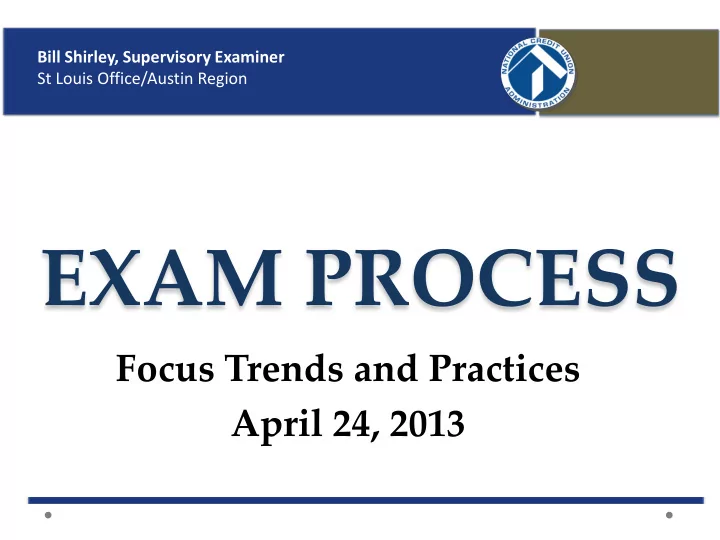

Bill Shirley, Supervisory Examiner St Louis Office/Austin Region EXAM PROCESS Focus Trends and Practices April 24, 2013
Bill Shirley, Supervisory Examiner St Louis Office/Austin Region Today’s Presenters Jim Capps, NCUA Principal Examiner Sarah Hartzel, NCUA District Examiner
Four Sections of Today’s Presentation 1. The three hats an Examiner wears 2. What we are looking for and how the Internal Auditor can help 3. The logical progression we take towards the Exam and DOR process 4. Current supervisory focus Presentation Title 2
Three Hats an Examiner Wears 1. Regulator 2. Insurer 3. Consultant Presentation Title 3
Regulator 1. Did we ID/address law/rule violations? 2. Did we educate management/staff on these? Presentation Title 4
Insurer 1. Did we ID/address Safety and Soundness Concerns? 2. Did we consider and convey the what- ifs? 3. Did we make the CU stop the risks they cannot sustain – both operationally and financially? Presentation Title 5
Consultant 1. Did we recommend/direct the CU to do things that will: 1. Better insulate them from the risks they are taking; 2. Better ensure their continued success and/or viability? Presentation Title 6
Presentation Title 7
Risk Focused Exam 1. Credit Risk 2. Interest Rate Risk 3. Liquidity Risk 4. Transaction Risk 5. Compliance Risk 6. Strategic Risk 7. Reputation Risk Presentation Title 8
From the IA perspective • What are the examiners looking for? • What can you provide to expedite the exam process? 9 Presentation Title 9
Credit Risk • Policies and procedures for each loan product • Enterprise-wide monitoring of lending programs • Internal controls and monitoring • New or planned programs • Delinquency data • Charge-off and recovery data • Static Pool Analysis • Paid ahead loan monitoring Presentation Title 10
Interest Rate Risk ALM Policy ALCO Minutes ALM reports including assumptions and validation Presentation Title 11
Liquidity Risk Liquidity Policy Investment Policy Investment Schedules Borrowed Funds Schedules Alternate Liquidity Sources Lines of credit-used, unused, advised, guaranteed, etc. Loan sales and participations Reverse Repurchase Agreements Presentation Title 12
Transaction Risk Supervisary committee audit report Reportable Conditions Letter Follow up recommendations Internal Audit program Procedures for verifying GL accounts CUMIS or other risk management audit Insider Account Review and monitoring Allowance for Loan Losses evaluation Multi-factor or Multi-layer authentication for internet access Presentation Title 13
Compliance BSA/OFAC and other compliance policies Risk Assessments Independent Testing CTRs and SARs filed since last exam Training Program Suspicious Activity Monitoring Presentation Title 14
Strategic Risk Budget Business Plan Strategic Plan Disaster Recovery Plans Succession Plans Vendor Listing and Oversight Presentation Title 15
Reputation Risk Member complaints SAS 70 Audit Board Minutes Presentation Title 16
Presentation Title 17
Logical Progression the Examiner Takes 18
Background/History 1. Review the last Exam/Contact 2. Review the status of any Administrative Actions 3. Review FPRs, Risk Reports and FOM 4. Identify/Consider any news sources, rumors, etc. 19 Presentation Title 19
Preliminary Risk Assessment & Exam Scope 1. Consider the background/history 2. Consider and changes since the last Exam 3. Consider the most recent Final Risk Assessment Direction 4. Extensiveness is dependent/consistent with Risk Rating 20 Presentation Title 20
Financial Trending 1. Anomaly Based Analysis Attuned to Oddities in the Trend Information. Usually Two Things: 1. Reporting Errors – Staff Changes, Inconsistencies or Intentional? 2. Deviations From Norms – Changes to Programs, Terms, Conditions, Policies or Philosophies? 2. Law of Averages – Do Averages Look Right? For example, Average Loan Size > Peer in Most Fraud Cases 3. NIM – NOE = bps of Disposable Income 21 Presentation Title 21
Final Risk Assessment 1. Conclusion/Support for CAMEL Ratings 2. Supports the Risk Level and changes from PRA 3. Indicates/Supports the Risk Direction 4. Extensiveness is dependent/consistent with Risk Rating 22 Presentation Title 22
Presentation Title 23
What is the DOR? 1. Outlines/Identifies the root of the problem 2. Willing to escalate to the next level of enforcement action if not resolved 3. Sets an action plan 4. Implements a timeframe management must address – either immediately or in a compressed period of time 24 Presentation Title 24
What is Included in the DOR? 1. Unsafe and unsound practices threatening the viability of the credit union 2. Systemic compliance violations 3. BSA violations 25 Presentation Title 25
Questions we ask to help qualify it as a DOR? 1. Is the problem pervasive? 2. If unresolved, could the problem cause financial or operational damage? 3. Is it in substantive noncompliance with laws and/or regulations? 4. Is the problem a result of management’s inability or unwillingness to properly identify, measure, monitor, and control the risk? 26 Presentation Title 26
Presentation Title 27
Current Exam Topics Please refer to your handouts for additional information and/or discussion on current NCUA examination issues and topics. Presentation Title 28
Capacity Focus Operational Risk Technology Internal Controls Balance Sheet Management IRR and Liquidity Risk Concentration Risk Less Established Products Presentation Title 29
Enhancing Clarity Improving Consistency Member Business Lending (MBL) Troubled Debt Restructuring (TDR) DOR and NSPM Pre-exam and Exam Report Cover Letter CU Online Profile – How to contact your SE and the District Examiner assigned to your credit union Presentation Title 30
Thank You! We appreciate your participation today. Our contact information is on the next slide. Any final questions? Presentation Title 31
Office Contact Page Feel free to contact our office with questions or comments. Primary Staff: Jim Capps, Principal Examiner (PE) jcapps@ncua.gov Sarah Hartzel, District Examiner (DE) shartzel@ncua.gov Secondary Staff: Bill Shirley, Supervisory Examiner (SE) wshirley@ncua.gov SE Shirley’s Phone : 703-609-6108 Presentation Title 32
Recommend
More recommend